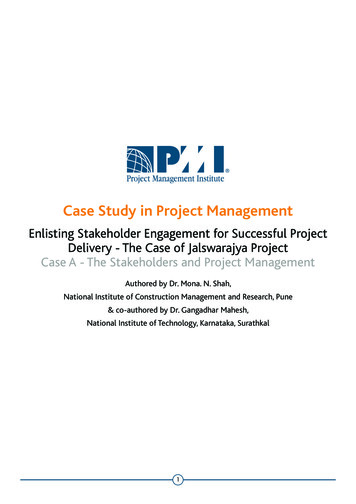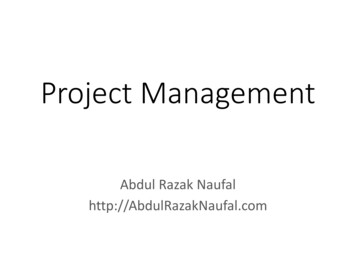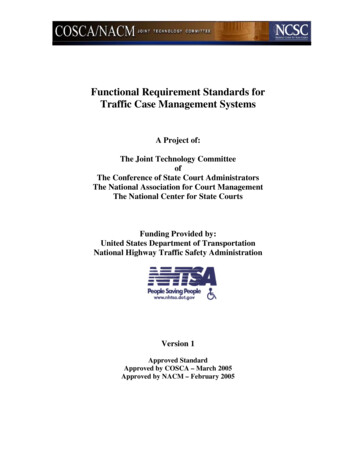
Transcription
Case Study in Project ManagementEnlisting Stakeholder Engagement for Successful ProjectDelivery - The Case of Jalswarajya ProjectCase A - The Stakeholders and Project ManagementAuthored by Dr. Mona. N. Shah,National Institute of Construction Management and Research, Pune& co-authored by Dr. Gangadhar Mahesh,National Institute of Technology, Karnataka, Surathkal1
CONTENTSBackground . 4The Genesis of Jalswarajya. 4Project Objectives. 4Stakeholder Identification. 5Role of Community Participation in Project Implementation. 6Selection of District as per Prioritization Criteria at District Level. 8Stakeholder Communication, Negotiation, Capacity Building Management. 8Community Stakeholder Communication. 9Community Negotiation. 9Community Capacity Building. 9Involving Stakeholders in Managing the Project. 9Jalswarajya Project Management Methodology.10Project Objectives.10Project Scope.10Project Cost.10Jalswarajya’s Project Management Principles.11Scope Management.11Time Management.11Human Resource Management.12Roles and Responsibilities Chart.12Institutional Arrangements and Interrelationships.12Project Team.13Quality Management.13Communication Management.13Risk Management.13Procurement Management.14Stakeholder Management.14Jalswarajya Project and Five Process Groups of PMI’s A Guide to the Project Management Body of Knowledge.14(PMBOK Guide)2
Plan Appraisal and Sanction.14Project Implementation Process.15Village Level Planning.15Community Implementation.16Operation and Maintenance.16Overall Outcome and Current Status.16Community Involvement in Project Phase.24Satisfaction Level Based on Outcome.24Present Status of Water Supply Scheme.24Process to Initiate the Jalswarajya Process in a Village. 7Prioritization Criteria for Districts. 8Component Wise Project Cost Estimate.11Jalswarajya Sub-Project Cycle.11Three-Tier Project Constituents and Structure.12Effectiveness of Information Dissemination Strategy.15Effectiveness of Negotiation Strategy.15Elements of a Project Charter.17Note on Water Ladder.17Mandatory Priorities that Make Jalswarajya Project Work.18Project Non-Negotiables.18Roles and Responsibilities Chart of Project Actors in Jalswarajya.19Plan Appraisal.21Project Implementation Process.21Village Level Planning.22Community Implementation Process.23Operation and Maintenance.233
Enlisting Stakeholder Engagement for Successful ProjectDelivery - The Case of Jalswarajya ProjectCase A - The Stakeholders and Project ManagementA.1 BackgroundIn 2000, the Government of Maharashtra, India, brought out a government resolution (GR) stating that Maharashtra willoperationalize an ‘innovative community driven approach’ in water management in the rural areas. The responsibilityof implementation of the project was assigned to the state’s Water Supply and Sanitation Department (WSSD). Untilthen, the official state arms, namely Maharashtra Jeevan Pradhikaran (MJP) and Zilla Parishad (ZP), had been entrustedwith the task of identifying the water and sanitation supply needs of rural communities. According to the GR “Villageresidents had little say in these matters and were also not required to pay for any of these services.”At that time, 63,298 villages/habitations (73.3 percent) were fully covered with portable water supply services, 21,521(24.93 percent) were partially covered, and the remaining 1,494 (1.73 percent) were not covered. In spite of spendingover Rs. 166,000 million, 26 percent of the rural habitations at the time did not have ‘assured’ water supply throughoutthe year. The majority of the habitations received intermittent water supply exacerbated by government’s operationsand maintenance machinery not being up to the mark. The situation was worse during summer in when water supplydried up and villages depended on water supplied through tankers.A.2 The Genesis of JalswarajyaThe prevailing problems in rural water supply were in the areas of non-participation and lack of capacity building ofcommunities to own and manage the infrastructure, and lack of standardized engineering designs and technology forwater management. This had affected the long-term, sustainable water supply in the villages.The state government decided to adopt the Government of India’s Sector Reform Policy that provided guidelines basedupon 1) participation of communities 2) driving of the program through Panchayati Raj Institutions (PRIs), and 3) longterm sustainability of services through technical and management operations by local communities. This was termedand popularly known as the ‘demand driven’ approach. The project was formally launched in 2003.A.3 Project ObjectivesAccording to the World Bank that partly funded the project, the development objectives of the Jalswarajya projectwere (i) increasing rural households’ access to improved and sustainable drinking water supply and sanitation services;and (ii) institutionalizing decentralization of rural water supply and sanitation (RWSS) service delivery to rural localgovernments and communities.4
The objectives assumed the need for altered priorities centred on the need to build the community and its ability tounderstand the project in its entirety. It meant focussing firstly on community development, involvement of women andindigenous people, and their capacity building. It, therefore, required the strengthening of the village panchayat . Thesecond priority involved the construction of the infrastructure for efficient water supply, i.e. strengthening of groundwater recharge and water supply schemes (such as digging of wells, provision of taps and tanks) and linking of schooland sanitation requirements. The third priority focussed on institutional strengthening such as district level capacitybuilding of the human resource in project management. It also contained the objectives of ensuring free informationflows and the establishment of a ‘non-confrontational’ approach to problem solving. The fourth objective was to ensuresector development and support such as knowledge management, policy support, and water quality measurement.Refer Appendix 3.Finally, it was deemed necessary to launch the full scale project at the village level only after the successful implementationof a pilot project. The pilot also contained other sub projects in ground water aquifer management and Operations andMaintenance (O&M) management.A.4 Stakeholder IdentificationImportant stakeholders that were identified in the project could be classified from the demand and the supply side asfollowsThe stakeholders from the demand side consisted of:1. Women: Women were deemed the most important stakeholders and their participation was mandatory for thelaunch and running of the scheme. Their mainstreaming was ensured through the compulsory presence of aminimum 50 percent quorum of women in gram sabha meetings. The women gram sabha preceded everygram sabha. Furthermore, all the key committees such as the Village Water Supply and Sanitation Committee(VWSC), Beneficiary Level Sub Committee (BLSC) and Social Audit Committee (SAC) needed to have at least 50percent women.2. Households and Beneficiaries were the primary stakeholders. These included the community of village residentsdrawn from households Below Poverty Line (BPL), backward classes, scheduled tribes, other marginalizedsections, women, and children.The stakeholders from the supply side consisted of:3. Government departments and the Government of Maharashtra: It is a three tiered system which has the villageat the bottom, then the zilla parishad, and finally, the government at the state level.a. Village level- panchayat samitis, talathis, gram sevak, anganwadi sevikas, teachers, watermen, and healthworkers were instrumental in driving the projectb. Zilla parishad- comprising of the District Water Management and Sanitation Committee (DWMSC), DistrictFacilitation Team (DFT), District Appraisal and Monitoring Team (DAMT), District Financial Management Team(DFMT), the administration wing, zilla parishad office bearers, and other related departmental heads andfunctionaries were instrumental in driving the project both at the state and village levels5
c. State level- the Operation and Monitoring Team (OMT) was the most important state level agency that wasassigned the responsibility of project implementation to ensure that stakeholders from the demand andsupply sides work together for project success. The other entities were the state level advisory committee onwater resources, WSSD, the Reform Support Monitoring Unit (RSMU), MJP,Groundwater SurveysDevelopment Agency (GSDA), Sector Policy Support Team (SPST), and empowered committee.4. Community Based Organizations (CBOs), Non Government Organizations (NGOs), Self Help Groups (SHGs):Groups such as mahila mandals (women’s organizations), youth mandals (female and male youth clubs), andwomen’s social groups played an active role in community mobilization.5. Gram sabha and panchayat samiti: While the gram sabha was involved with the cause of participatory decisionmaking, collective action, and championing the project, the panchayat samiti was responsible for providingsecretarial and monitoring assistance to the gram sabha, VWSC, and Social Audit Committee.6. Funding Agencies: Germany based Kreditanstalt fur Wiederaufbau (KfW), World Bank, Government of India,and International Development Assistance (IDA) contributed Rs. 937.61 crore, and the Government ofMaharashtra’s contribution was Rs. 377.10 crore. The total project size was Rs. 1395.53 crore. The communitiestoo had to contribute around 5.8 percent of the project cost, amounting to Rs. 80.82 crore.A.5 Role of Community Participation in Project ImplementationThe community initiative remains the cornerstone of all Jalswarajya projects . The project was initiated at the level ofthe GS after the women gram sabha had discussed and agreed to the Jalswarajya project to be launched in the village.This proposal was then forwarded to the Zilla Parishad (ZP). Officials from the ZP were required to attend the GSmeeting and explain to the village communities the details of the project and play an advisory role. They had to ensurethat the stipulated criteria stated in Exhibit A.1 had been fulfilled before proposing the project at the state level. Theseincluded the formation of the VWSC, as per specifications, its account opening with a bank, and its readiness to procureand execute the project. Exhibit A. 1 illustrates the process to initiate the project in a village.However, for actual initiation of the Jalswarajya project, the villagers had to demonstrate their capacity, will, and initiativeto make their village ‘water deficit free’ and ‘open defecation free’. It was mandatory for every village that wished tolaunch the project to create a women empowerment fund and a Women Development Committee (WDC) with at least75 percent participation of women. All women’s groups federated at the village level to avail of credit and were, in turn,linked to financial institutions. For the Village Panchayat (VP), which had to play a central role in implementing theproject, steps were to be taken to strengthen and enable the VPs to perform their roles efficiently and effectively. Theyhad to undergo coaching in financial management, social audit processes, and hygiene promotion, besides transparentdecision-making and strengthening the linkage between CBOs and VPs. The qualifying VPs received Rs. 25000 towardsInformation, Education, and Communication (IEC) for initial efforts. Technical assistance was provided to improve theviability and effectiveness of the existing and new water supply systems.6
Exhibit A.1: Process to Initiate the Jalswarajya Process in a VillageResolution passed by Gram Sabha to be forwarded to Zilla ParishadGram PanchayatZilla ParishadSolicit prior views of all stakeholders - wards/ wadies/ habitations/mahila mandalsGram SabhaStakeholdersConcerned officers to attend Gram Sabha meeting to provide information andguidanceZilla Parishad to suggest specific schemes to Gram Sabha, in case they are notaware of the suitability of a scheme to the villageat the time of proposal submission to ascertain- 1) the constitution of VWSC,2) VWSC to comprise at least 50% women, and backward representation,3) procurement and execution to be done by VWSC ,4) bank account in the name of VWSC7
A.6 Selection of District as per Prioritization Criteria at District LevelA system of village selection was proposed from 33 districts, based on factor wise weightage assigned to three majorcriteria. Villages had to clearly demonstrate their suitability to be considered for selection and subsequent funding.Refer Exhibit A.2.Exhibit A.2: Prioritization Criteria for DistrictsCriteriaWeight/percentage1) Need for the Project45a. Drought proneness of the district10b. Number of tankers deployed in the district in the past 3 years10c. Number of NC habitations in the district10d. Number of habitations with No Safe Sources (NSS)10e. Number of BPL or other partially covered inhabitants052) Socio-Economic Characteristics25a. Percentage of tribal (indigenous people) population10b. Percentage of backward class population05c. Number of BPL population of the district103) Potential of District30a. Implementation of Sant Gadge Baba Village Sanitation Campaign10b. Implementation of Shiv Kalin Water Harvesting Scheme05c. Mahatma Phule Jal Bhumi Sandharan05d. Yashwant Rural Development Scheme10A.7 Stakeholder Communication,Negotiation, Capacity Building ManagementOnce the initial stages in the application for the project by a village was completed, the district team along heldfrequent meetings with the villagers to negotiate various issues. A door-to-door, baseline survey was conducted tofind out how much water was available and how much water each household consumed. This was followed by theParticipatory Rural Appraisal (PRA). The PRA contained the village map, timeline, gradation of water source in the villageand so on. The district level teams visited the village with a checklist to decide for three sub-projects that would haveto run simultaneously as part of the Jalswarajya project in the village. These sub-projects were. (a) The level of activeparticipation of committees for the formulation of each sub-project, (b) Communicating with villagers through informaland formal discussions about their approach to the different components of the project, and (c) recruiting volunteersfrom among the villagers and involving gram panchayat officials. The DFT, DMT, NGOs, and the technical team helpedvillagers form the required committees. The technical service provider was appointed by the village committees(VWSC, WDC) and approved by the gram sabha. In Kalwan village in Nashik district, women came forward and formeda committee with 100 percent women when the minimum stipulation was of 75 percent. These women’s committeesbegan learning how to maintain records of water consumed and financial accounting.8
A.7.1 Community Stakeholder CommunicationCommunication with the community stakeholders was a major challenge due to the heterogeneous nature of thevillage demography. Unusual solutions were used to mobilize villagers and inculcate the appropriate orientation amongthem. Villagers did not prefer reading material; instead, the team found exposure visits of villagers to other villageswhere Jalswarajya was in operation and group meetings to be more effective in explaining the project scope. Posters,audio visual tools, wall paintings, and radio talks were also used to sensitize villagers.A.7.2 Community NegotiationThe responsibility to help the community to formulate the most appropriate communication and negotiation optionsfor the village rested with the various village level project committees, village level volunteers, and gram sabha officials.NGOs that were part of the project conducted a series of discussions and negotiations using checklists drawn up bythe district level teams. From time to time, the district teams visited the village to monitor the social processes andpublic participation in decision-making processes. Their role was also to provide inter-departmental linking support atthe district level for the activity.The village community was heterogeneous. Women and villagers from tribal communities were typically the leastempowered sections. The NGOs used various techniques of negotiation to manage internal conflicts and align variousvillage sections to focus on the core objective. Project committee representatives found collaborating (mutual problemsolving) and accommodating as the most effective approach for negotiation with beneficiaries of schemes. However, attimes a combination of approaches was used to drive project objectives and achieve community agreement.A.7.3 Community Capacity BuildingIn order to achieve this level of understanding and commitment, the community’s initiation into basic projectmanagement principles was necessary. Coaching was aimed at helping the community understand the importanceof enlisting the immediate stakeholder support, interfaces with government agencies and departments, and fundplanning and deployment. The community’s ability to understand the entire project scope, technicalities, financing,and administration arrangements were considered as a prerequisite for project success. Therefore, the components ofcommunity capacity building were identified and deployed at project sites. Community capacity building consisted ofimparting training to the Village Water Supply and Sanitation Committee (VWSC) and the gram sabha as the monitoringbody of VWSC. It meant teaching them how to prepare the Drinking Water and Sanitation Plan, providing technicalhelp in marketing, finance, account keeping, and micro enterprise development. Training also comprised of developingsolutions for providing financial support for seed money for BPL families . Capacity building was a time-consumingexercise. However, it helped bring all strata of village society to rally around the project. It resulted in a high level oftransparency and a sense of identification with the cause.A.8 Involving Stakeholders in Managing the ProjectAfter the success of the pilot project in three districts, the Jalswarajya project was launched in 26 districts of Maharashtra.Project management principles were detailed out in a highly comprehensive 400 page document, the Jalswarajya ProjectImplementation Plan (PIP), brought out by the project sponsor. The that was circulated to all stakeholders in September 2003.9
A.8.1 Jalswarajya Project Management MethodologyThe Jalswarajya project contained many project management tools and techniques. The project charter, though nottermed the same at the time, contained elements like the project scope, objectives, budgets, and implementation.Even though it was a social development project, some of the most important project management principles wereelaborated in the Jalswarajya PIP. Refer Appendix 1 for elements of project charter.The Jalswarajya project charter contained the following elements:A.8.1(a) Project Objectives:1. To increase rural households’ access to improved and sustainable drinking water and sanitation services.2. To institutionalize decentralization of rural water supply and sanitation service delivery to rural localgovernments and committees.A.8.1 (b) The Project Scope: The project scope was envisaged as a Government of Maharashtra’s initiative tooperationalize state-wide implementation of the reform agenda in the rural water supply and sanitation sector. Theproject acknowledged the necessity of a high degree of learning, experimenting, and piloting to institutionalize the newsectoral policies.The major project components are listed in Exhibit A.3A.8.1(c) Project Cost: The total cost of the project, including taxes, duties and physical and price contingencies, wereestimated at Rs. 13,955.25 million or US 268.60 million equivalent (in 2003). Refer Exhibit A.3 for the project costestimate.10
Exhibit A.3: Component Wise Project Cost EstimateS. No.Component DescriptionAmount in INR million (US million)Percentage oftotal base cost1Community Development and InfrastructureRs. 8203.62 (174.93)702Institutional StrengtheningRs. 2372.59 (50.58)203Rural Water Supply Sector StrengtheningRs. 197.49 (4.21)24Pilot ComponentsRs. 551.42 (11.76)55Contingencies/UnallocatedRs. 2630.13 (27.09)106Total ( Point 5)Rs. 13955.25 (268.57)100 ( 107)A.9 Jalswarajya’s Project Management PrinciplesThe processes covering key principles of project management are described below.A.9.1 Scope Management:The project was restricted only to those villages where the quantity and quality of available water and sanitationfacilities was below par, high presence of BPL and tribal families, villages with a good track record of paying water duesto the government in earlier state-run schemes, and willing to adhere to the prescribed project rules. The project wasdesigned to benefit about 7.5 million rural inhabitants, rising the number to about 10 million by the end of the projectperiod. The project deliverables were clear: the village folk saved time in collecting water, increased availability of safewater sources, health benefits from access to safe water, and sanitation related benefits. It aimed to help save highcapital and O&M costs incurred by existing government schemes. Lastly, it was to promote entrepreneurial activities toincrease income of villagers and empower women.A.9.2 Time Management:The project was chosen to be launched in a village panchayat that took the initiative on Information, Educationand
Enlisting Stakeholder Engagement for Successful Project Delivery - The Case of Jalswarajya Project Case A - The Stakeholders and Project Management Authored by Dr. Mona. N. Shah, National Institute of Construction Management and Research, Pune & co-authored by Dr. Gangadhar Mahesh, National Institute of Technology, Karnataka, Surathkal










